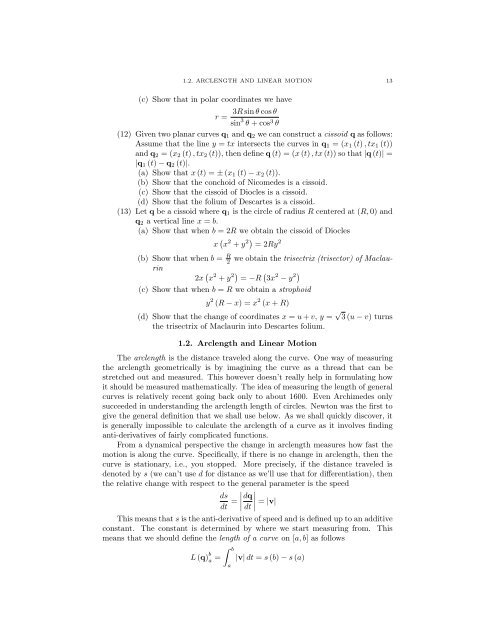Lecture Notes for 120 - UCLA Department of Mathematics
Lecture Notes for 120 - UCLA Department of Mathematics
Lecture Notes for 120 - UCLA Department of Mathematics
You also want an ePaper? Increase the reach of your titles
YUMPU automatically turns print PDFs into web optimized ePapers that Google loves.
1.2. ARCLENGTH AND LINEAR MOTION 13<br />
(c) Show that in polar coordinates we have<br />
3R sin ✓ cos ✓<br />
r =<br />
sin 3 ✓ + cos 3 ✓<br />
(12) Given two planar curves q 1 and q 2 we can construct a cissoid q as follows:<br />
Assume that the line y = tx intersects the curves in q 1 =(x 1 (t) ,tx 1 (t))<br />
and q 2 =(x 2 (t) ,tx 2 (t)), thendefineq (t) =(x (t) ,tx(t)) so that |q (t)| =<br />
|q 1 (t) q 2 (t)|.<br />
(a) Show that x (t) =± (x 1 (t) x 2 (t)).<br />
(b) Show that the conchoid <strong>of</strong> Nicomedes is a cissoid.<br />
(c) Show that the cissoid <strong>of</strong> Diocles is a cissoid.<br />
(d) Show that the folium <strong>of</strong> Descartes is a cissoid.<br />
(13) Let q be a cissoid where q 1 is the circle <strong>of</strong> radius R centered at (R, 0) and<br />
q 2 averticallinex = b.<br />
(a) Show that when b =2R we obtain the cissoid <strong>of</strong> Diocles<br />
x x 2 + y 2 =2Ry 2<br />
(b) Show that when b = R 2<br />
we obtain the trisectrix (trisector) <strong>of</strong> Maclaurin<br />
2x x 2 + y 2 = R 3x 2 y 2<br />
(c) Show that when b = R we obtain a strophoid<br />
y 2 (R x) =x 2 (x + R)<br />
(d) Show that the change <strong>of</strong> coordinates x = u + v, y = p 3(u<br />
the trisectrix <strong>of</strong> Maclaurin into Descartes folium.<br />
1.2. Arclength and Linear Motion<br />
v) turns<br />
The arclength is the distance traveled along the curve. One way <strong>of</strong> measuring<br />
the arclength geometrically is by imagining the curve as a thread that can be<br />
stretched out and measured. This however doesn’t really help in <strong>for</strong>mulating how<br />
it should be measured mathematically. The idea <strong>of</strong> measuring the length <strong>of</strong> general<br />
curves is relatively recent going back only to about 1600. Even Archimedes only<br />
succeeded in understanding the arclength length <strong>of</strong> circles. Newton was the first to<br />
give the general definition that we shall use below. As we shall quickly discover, it<br />
is generally impossible to calculate the arclength <strong>of</strong> a curve as it involves finding<br />
anti-derivatives <strong>of</strong> fairly complicated functions.<br />
From a dynamical perspective the change in arclength measures how fast the<br />
motion is along the curve. Specifically, if there is no change in arclength, then the<br />
curve is stationary, i.e., you stopped. More precisely, if the distance traveled is<br />
denoted by s (we can’t use d <strong>for</strong> distance as we’ll use that <strong>for</strong> differentiation), then<br />
the relative change with respect to the general parameter is the speed<br />
ds<br />
dt = dq<br />
dt<br />
= |v|<br />
This means that s is the anti-derivative <strong>of</strong> speed and is defined up to an additive<br />
constant. The constant is determined by where we start measuring from. This<br />
means that we should define the length <strong>of</strong> a curve on [a, b] as follows<br />
ˆ b<br />
L (q) b a = |v| dt = s (b)<br />
a<br />
s (a)
















